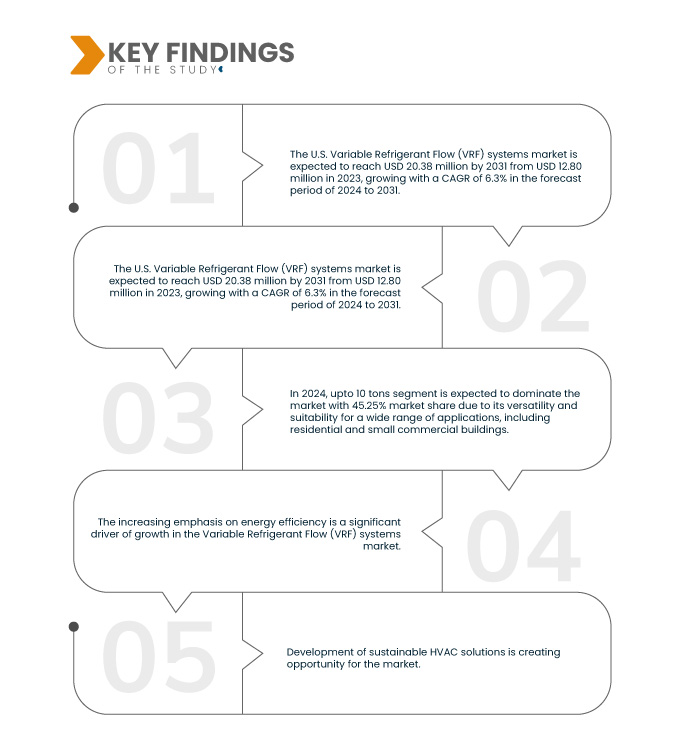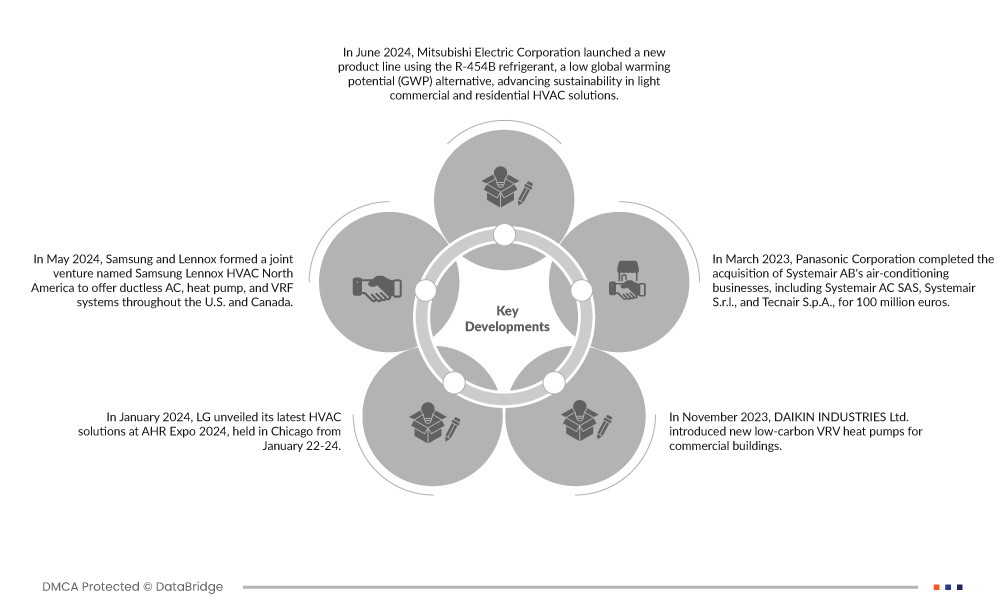As global awareness of climate change and energy conservation rises, businesses and homeowners are seeking HVAC solutions that minimize energy consumption and reduce operating costs. VRF systems, known for their superior energy efficiency compared to traditional HVAC systems, are gaining popularity due to their ability to provide precise temperature control while optimizing energy use. By modulating the refrigerant flow to match the heating or cooling demand of individual zones, VRF systems significantly lower energy consumption, making them an attractive option for both new installations and retrofits in commercial and residential buildings.
Access Full Report @ https://www.databridgemarketresearch.com/ko/reports/us-variable-refrigerant-flow-vrf-systems-market
Data Bridge Market Research analyzes that the U.S. Variable Refrigerant Flow (VRF) Systems Market is expected to reach USD 20.38 billion by 2031 from USD 12.80 billion in 2023, growing with a CAGR of 6.3% in the forecast period of 2024 to 2031.
Key Findings of the Study
Increasing Adoption of Smart Buildings/IoT-Based VRF Systems
As buildings become more connected and intelligent, the integration of VRF systems with IoT enables precise control, monitoring, and optimization of heating and cooling functions in real time. These systems allow for the seamless management of energy consumption, improving efficiency and reducing costs, which is particularly appealing in commercial and large-scale residential projects. The ability to remotely adjust settings, predict maintenance needs, and analyze performance data enhances the appeal of VRF systems in smart building environments.
Report Scope and Market Segmentation
|
Report Metric
|
Details
|
|
Forecast Period
|
2024 to 2031
|
|
Base Year
|
2023
|
|
Historic Year
|
2022 (Customizable to 2016-2021)
|
|
Quantitative Units
|
Revenue in Billion
|
|
Segments Covered
|
Components (Outdoor Units, Indoor Units, Control Systems, and Accessories), Capacity (Upto 10 Tons, 11 to 18 Tons, 19 to 26 Tons, and Above 26 Tons) System Type (Heat Pump Systems and Heat Recovery Systems), Application (Commercial, Residential, and Others)
|
|
Country Covered
|
U.S.
|
|
Market Players Covered
|
Samsung HVAC, LLC (A subsidiary of Samsung Electronics) (U.S.), DAIKIN INDUSTRIES, Ltd. (Japan), Panasonic Holdings Corporation (Japan), Mitsubishi Electric Corporation (Japan), LG Electronics (South Korea), FUJITSU GENERAL (Japan), Ingersoll Rand (U.S.), Johnson Controls Inc. (Ireland), Lennox International Inc (U.S.), and Midea (China) among others
|
|
Data Points Covered in the Report
|
In addition to the insights on market scenarios such as market value, growth rate, segmentation, geographical coverage, and major players, the market reports curated by the Data Bridge Market Research also include in-depth expert analysis, geographically represented company-wise production and capacity, network layouts of distributors and partners, detailed and updated price trend analysis and deficit analysis of supply chain and demand.
|
Segment Analysis
The U.S. Variable Refrigerant Flow (VRF) systems market is segmented into four notable segments, which are based on components, capacity, system type, and application.
- On the basis of components, the market is segmented into outdoor units, indoor units, control systems, and accessories
In 2024, outdoor units segment is expected to dominate the U.S. Variable Refrigerant Flow (VRF) systems market
In 2024, outdoor units segment is expected to is expected to dominate the market with 39.15% market share due to its critical role in overall system efficiency and performance, offering advanced features such as enhanced heat exchange and energy-saving capabilities.
- On the basis of capacity, the market is segmented into Upto 10 tons, 11 to 18 tons, 19 to 26 tons, and above 26 tons
In 2024, upto 10 tons segment is expected to dominate the U.S. Variable Refrigerant Flow (VRF) systems market
In 2024, upto 10 tons segment is expected to dominate the market with 45.25% market share due to its versatility and suitability for a wide range of applications, including residential and small commercial buildings.
- On the basis of system type, the market is segmented into heat pump systems and heat recovery systems. In 2024, heat pump systems segment is expected to dominate the market with 57.94% market
- On the basis of application, the market is segmented into commercial, residential, and others. In 2024, the commercial segment is expected to dominate the market with 61.89% market share
Major Players
Data Bridge Market Research analyzes Samsung HVAC, LLC (A subsidiary of Samsung Electronics) (U.S.), DAIKIN INDUSTRIES, Ltd. (Japan), Panasonic Holdings Corporation (Japan), Mitsubishi Electric Corporation (Japan), LG Electronics (South Korea) as the major players operating in the market.
Market Developments
- In June 2024, Mitsubishi Electric Corporation launched a new product line using the R-454B refrigerant, a low global warming potential (GWP) alternative, advancing sustainability in light commercial and residential HVAC solutions. Available in early 2025, these products exceed regulatory requirements and feature enhanced cold climate performance and safety. This launch has strengthened Mitsubishi Electric’s commitment to environmental stewardship, boosting its market position as a leader in sustainable HVAC solutions
- In May 2024, Samsung and Lennox formed a joint venture named Samsung Lennox HVAC North America to offer ductless AC, heat pump, and VRF systems throughout the U.S. and Canada. This partnership enhances Samsung's distribution and market reach for its Variable Refrigerant Flow (VRF) systems, utilizing Lennox's established sales network and market presence
- In January 2024, LG unveiled its latest HVAC solutions at AHR Expo 2024, held in Chicago from January 22-24. The event showcased LG's energy-efficient residential and commercial HVAC lineups, including the R32 air-to-water heat pump and the Multi V i VRF solution. These innovations highlighted LG's commitment to sustainability and whole-home electrification. This strategic showcase reinforced LG's strong market position and bolstered its reputation as a leader in smart home solutions
- In November 2023, DAIKIN INDUSTRIES Ltd. introduced new low-carbon VRV heat pumps for commercial buildings. The VRV 5 heat pumps, set for release in early 2024, include the Mini-VRV system with a capacity of up to 33.5 kW and the Top-Blow series reaching 56 kW. These systems use R-32 refrigerant, which has a Global Warming Potential of 675, reducing CO2-equivalent emissions by up to 71% in line with European regulations. This advancement supports Daikin's goal of leading in decarbonization efforts and enhancing its market position in sustainable building solutions
- In March 2023, Panasonic Corporation completed the acquisition of Systemair AB's air-conditioning businesses, including Systemair AC SAS, Systemair S.r.l., and Tecnair S.p.A., for 100 million euros. This acquisition benefits Panasonic Holdings Corporation by enhancing its ability to meet growing environmental demands and regulations in Europe. By integrating Systemair's commercial hydronic systems with its own VRF systems, Panasonic can develop more efficient, environmentally friendly air-conditioning solutions, strengthening its market position and expanding its product offerings
For more detailed information about the U.S. Variable Refrigerant Flow (VRF) systems market report, click here – https://www.databridgemarketresearch.com/ko/reports/us-variable-refrigerant-flow-vrf-systems-market















